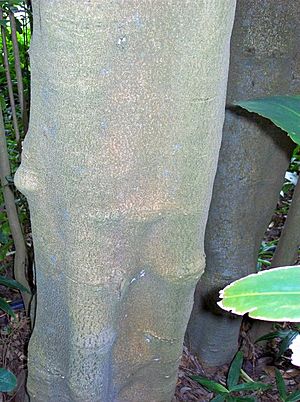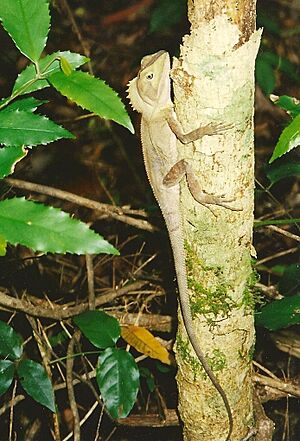Manning River socketwood facts for kids
Quick facts for kids Manning River socketwood |
|
|---|---|
 |
|
| Manning River socketwood - trunk | |
| Scientific classification | |
| Genus: |
Daphnandra
|
| Species: |
micrantha
|
| Synonyms | |
|
|
The Manning River socketwood (Daphnandra micrantha) is a special tree that grows in the rainforests of eastern Australia. You can often find it growing close to streams. This tree is mostly found in the Manning River and Hastings River valleys in northern New South Wales. It also grows in areas where different types of forests meet, like where brush box and tallowwood trees are common.
About Its Name
The Manning River socketwood belongs to a very old plant family called Atherospermataceae. This family has been around since the time of Gondwana, a supercontinent that existed millions of years ago.
The name Daphnandra comes from Greek words. Daphne means "Bay Laurel," and andros means "man." This name was chosen because the tree's flower parts (called anthers) look a bit like those of the Bay Laurel tree. The second part of its name, micrantha, also comes from Greek and means "small flowers."
These trees are called "socketwood" because of how their branches connect to the main trunk. It looks a bit like a "ball and socket" joint, similar to how your arm connects to your shoulder!
What Does It Look Like?
The Manning River socketwood is a small to medium-sized tree. It can grow up to 20 metres (about 65 feet) tall. Its trunk can be about 25 centimetres (10 inches) wide.
The bark of the tree is a creamy fawn colour and has vertical cracks. Unlike some other socketwood trees, its smaller branches do not have soft, fuzzy hairs. The branchlets (small branches) are flattened where they join the main stem.
Leaves
The leaves of the Manning River socketwood grow in pairs on the stem. They are usually 7 to 17 centimetres (about 3 to 7 inches) long and 1 to 5 centimetres (about 0.4 to 2 inches) wide. Each leaf has fine teeth along its edges, usually around 14 teeth on each side.
The main vein (midrib) of the leaf sticks out on the underside but is sunken on the top. You can also see about five pairs of side veins, which are clearer on the underside of the leaf. The leaf stem is quite short, only 3 to 8 millimetres (about 0.1 to 0.3 inches) long.
Flowers and Fruit
This tree produces small flowers from June to October. They can be greenish-white or pinkish-green.
After the flowers, the tree forms a woody fruit. This fruit splits open into two parts. Inside, it releases small, hairy seeds called achenes. These seeds are very light and can be carried away by the wind, helping the tree spread to new places.


